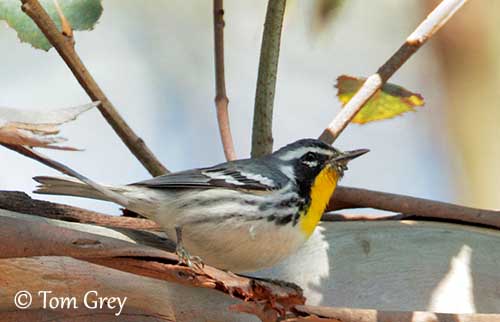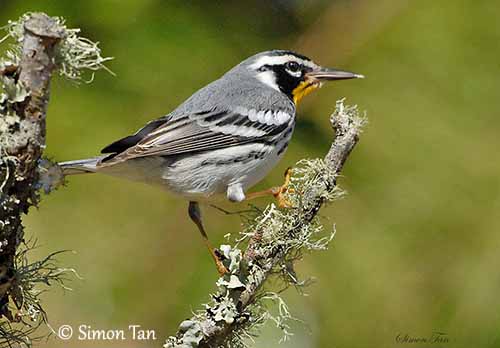
Fr: Paruline à gorge jaune
Ang: Yellow-throated Warbler
All: Goldkehl-Waldsänger
Esp: Reinita Gorjiamarilla
Ita: Parula golagialla
Nd: Geelkeelzanger
Sd: Gulstrupig skogssångare
Photographers:
Tom Grey
Tom Grey's Bird Pictures
Ken Havard
My Bird Gallery & Flickr gallery 1 & Flickr gallery 2
Simon Tan
PBase Bird galleries
Text by Nicole Bouglouan
Sources:
HANDBOOK OF THE BIRDS OF THE WORLD Vol 15 by Josep del Hoyo-Andrew Elliot-David Christie - Lynx Edicions – ISBN: 9788496553682
A GUIDE TO THE BIRDS OF MEXICO AND NORTHERN CENTRAL AMERICA by Steve N. G. Howell, Sophie Webb - Oxford University Press - ISBN: 0198540124
BirdLife International (BirdLife International)
All About Birds (Cornell Lab of Ornithology)
What Bird-The ultimate Bird Guide (Mitchell Waite)
Bird Web (Seattle Audubon Society)
About.com – Birding / Wild Birds
Yellow-throated Warbler
Setophaga dominica
Passeriformes Order – Parulidae Family
INTRODUCTION:
The Yellow-throated Warbler is a woodland species. It forages in bark crevices and foliage in trees, and as this warbler has longer bill than other Parulidae species, the birds avoid competition for food.
DESCRIPTIONOF THE BIRD:
Biometrics:
Length: 14 cm
Wingspan: 22 cm
Weight: 9-11 g
The Yellow-throated Warbler has black crown and face. Throat and upper breast are yellow, and rests of underparts are white, with some black streaks on flanks. The rear crown, nape and upperparts are grey, and we can see two white wing bars, and white spots on the outer four undertail feathers.
The black face connects with stripes on flanks. The Yellow-throated Warbler has a white supercilium and neck sides, a white ear patch and white crescent under eye.
Eyes, bill and legs are black. The bill is long, thin and slightly decurved.
Both sexes are similar, but the female is duller. She has less extensive black on face with mostly grey streaked black forecrown. She may have a brownish wash on back.
The immature is similar to adult, but duller.

SUBSPECIES AND RANGE:
The Yellow-throated Warbler breeds from Iowa to Pennsylvania and New Jersey, southwards to eastern Texas and Florida. It winters from Georgia and Texas, southward to Central America and Caribbean.
There are four recognized subspecies:
S.d. albilora breeds from E Iowa, SE Kansas and C Texas, E to Appalachians. It winters mainly in E Mexico, S to Nicaragua. This race has conspicuous and longer white supercilium and shorter bill than nominate.
S.d. dominica (described above) breeds E of Appalachians from Pennsylvania, S to C Florida. It winters in SE USA and Caribbean (Bahamas and Greater Antilles).
S.d. stoddardi occurs in NW Florida and coastal Alabama. This one has longer and more slender bill than nominate. It is sedentary.
S.d. flavescens occurs in N Bahama Islands. This race has paler yellow throat, with yellow extending to vent. The upperparts are duller grey. The white patch on the neck side is smaller. This race is sedentary.
HABITAT:
The Yellow-throated Warbler is fairly common in oak and pine woodlands, cypresses and sycamores, also in swamps and riparian woodlands.
During the migration and in winter, it is found in a variety of woodlands, scrubs, brushes and thickets, but it prefers pine woodland if available.
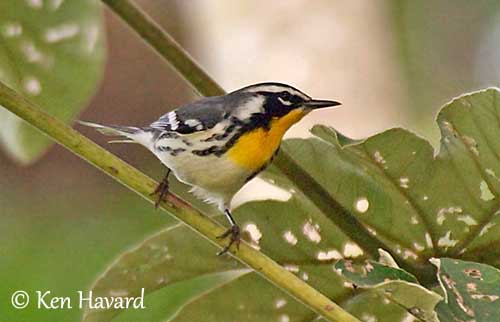
CALLS AND SONGS: SOUNDS BY XENO-CANTO
The Yellow-throated Warbler’s song is a series of clear, down slurred whistles ending with a rising note. The call is a high “see” or a sharp “chip”.
BEHAVIOUR IN THE WILD:
The Yellow-throated Warbler feeds on insects, such as beetles, moths and their larvae, flies, grasshoppers, crickets, bugs, and also spiders. It is mainly insectivorous, but it will take some berries and nectar in winter.
It usually forages high in the trees, by creeping methodically along the branches. It probes into cracks, crevices, bundles of pine needles and Spanish moss (Tillandsia usneoides). It gleans much of its food from leaves and branches, and spends most of its time at top of tall sycamores (Platanus occidentalis).
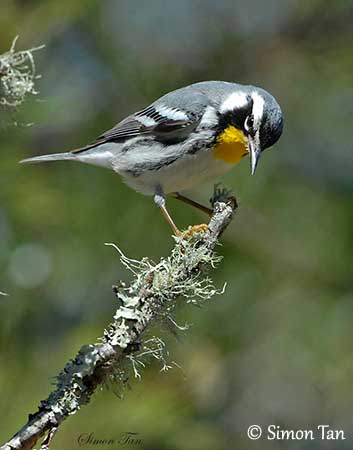
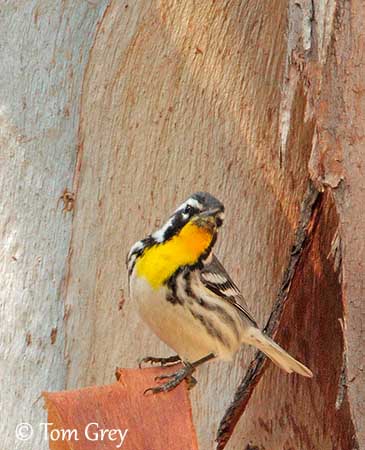
The Yellow-throated Warbler moves up and down, sidewise and spirally, along trunks, branches and even twigs of the tallest and largest cypresses and other tall trees. It is extremely active. It suddenly leaves the uppermost branches of the higher part of the trunk to dive downwards and alight on the roots. It renews its search after small insects and larvae. But it doesn’t pursue insects on the wing.
The male defends the territory by singing as soon as it returns to the breeding grounds in early spring. The pair is probably monogamous, and mates remain together during the breeding season. The male sings loudly from treetops to attract a mate.
The Yellow-throated Warblers of races albilora and dominica migrate southwards in winter. The migration occurs partially by night. Both races stoddardi and flavescens are sedentary in their ranges.
This warbler performs agile and rapid flight.
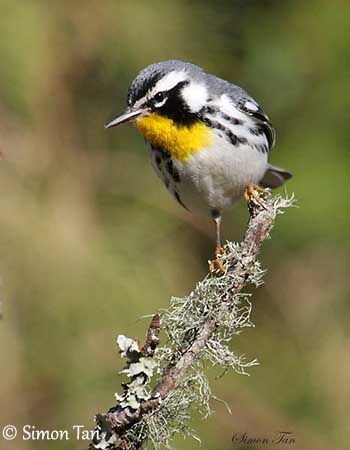
REPRODUCTION OF THIS SPECIES:
The breeding season occurs between April and August.
The Yellow-throated Warbler’s nest is located at 3-40 metres above the ground, on horizontal branch. It is usually hidden among clumps of Spanish moss or pine needles.
The nest is an open cup, often a cup-shaped pocket made with grasses, bark stripes and weed stems. It is lined with plant down, feathers and strands of moss, woven into the nest. The nest resembles a knot or a tuft of moss.
The female lays 3 to 5 dull green-white or grey-white eggs, speckled and blotched with lavender, grey and wine red. The incubation lasts about 12 to 13 days. The young fledge 8 days after hatching.
This species produces two broods per year in the south of its range.
PROTECTION / THREATS / STATUS:
The Yellow-throated Warbler is common throughout its wide range, although the race stoddardi is rare in NW Florida.
The Shiny Cowbird could be a possible threat for the race flavescens in the future.
However, the global population is slowly increasing, and expanding the breeding range northwards.
The Yellow-throated Warbler is currently evaluated as Least Concern.
